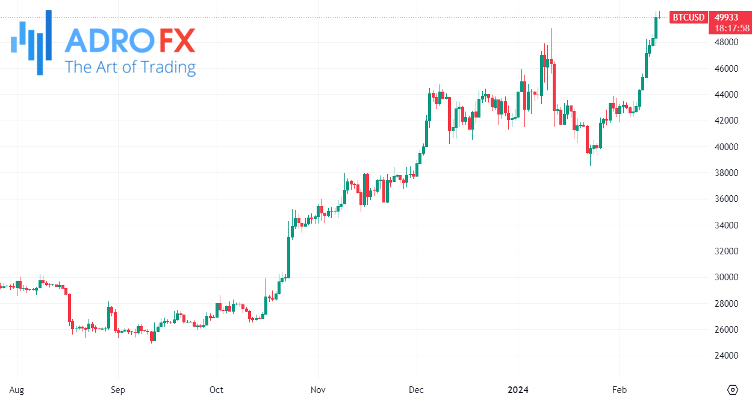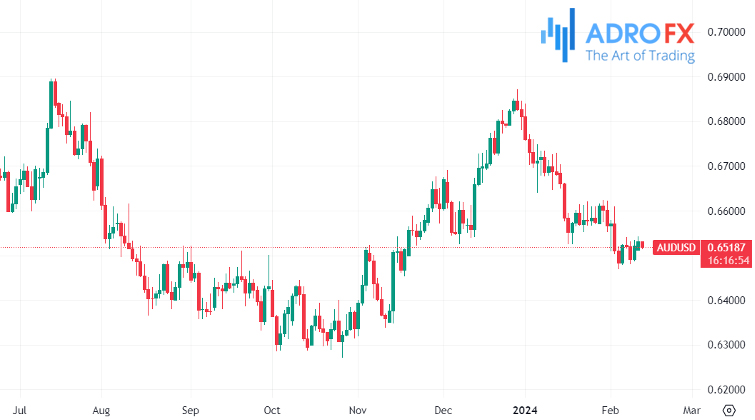Nasdaq Falters, Bitcoin Surges, and Global Currencies Face Pressure Amid Economic Data Awaited | Daily Market Analysis

Key events:
- UK - Claimant Count Change (Jan)
- UK - Employment Change 3M/3M (MoM) (Dec)
- UK - Unemployment Rate (Dec)
- USA - Core CPI (MoM) (Jan)
- USA - CPI (MoM) (Jan)
- USA - CPI (YoY) (Jan)
On Monday, the Nasdaq experienced a decline in the afternoon, briefly surpassing its previous record closing high from November 2021. Simultaneously, the Dow recorded a modest rise in anticipation of two crucial US inflation reports scheduled for the week, poised to influence Federal Reserve policy.
While the S&P 500 closed slightly lower, it maintained its position just above the 5,000-point threshold achieved on Friday. Investors eagerly awaited this week's releases of January's Consumer Price Index and Producer Price Index to assess potential implications for interest rate adjustments. Additionally, the market anticipated data on industrial production, retail sales, and the preliminary University of Michigan consumer sentiment.
The Dow Jones Industrial Average, a blue-chip index, marked a 0.3% rise, reaching a fresh record closing of 38,797.38. In contrast, the tech-focused Nasdaq Composite experienced a 0.3% decline, and the S&P 500 dipped 0.1% after reaching an intraday record of 5,048.56.

Over the past four months, megacaps, particularly those heavily involved in artificial intelligence, have led a bull market on Wall Street. This surge, fueled by optimism about imminent rate cuts and positive business outlooks, has benefited various stocks.
During the trading session, Nvidia briefly surpassed Amazon.com in market capitalization, securing the position of the fourth-most valuable US company. However, by the end of the day, Amazon retained its lead, with Nvidia closing up 0.16%, while Amazon dipped 1.2%.

Federal Reserve officials remained steadfast in their stance against early rate cuts. Governor Michelle Bowman emphasized the need for tight monetary policy measures to curb inflation, stating that she does not anticipate rate cuts in the immediate future. These comments preceded the release of fresh inflation data, with the US consumer price index for January expected to reveal a slowdown in headline price growth on both an annual and monthly basis.
In the cryptocurrency sphere, Bitcoin attained an over two-year high on Tuesday, crossing key levels amid consistent capital inflows into recently approved spot exchange-traded funds. Bitcoin recorded a 3.2% rise, reaching $50,160.2 and surpassing the $50,000 mark for the first time since December 2021. Despite this surge, it remained approximately $19,000 away from setting new record highs.

Bitcoin's gains were attributed to ongoing capital flows into recently approved spot ETFs, with net inflows exceeding $1 billion in the past week, according to digital asset management firm CoinShares. BlackRock Inc's iShares Bitcoin Trust saw the most significant inflows for the week, totaling about $690 million.
Market attention was also directed toward an upcoming halving event expected in April. This event, which reduces the rate of new bitcoins generated by 50%, has historically triggered rallies in the cryptocurrency. The most recent halving in May 2020 preceded a 50% spike in bitcoin prices.
For the second straight session, the NZD/USD pair extended its descent, approaching 0.6110 in the Asian trading session on Tuesday. The New Zealand Dollar encountered resistance against the US Dollar, influenced in part by diminished inflation expectations for the Kiwi in the first quarter. The RBNZ Inflation Expectations (QoQ) rose by 2.5%, a decline from the preceding reading of 2.7%.

During Monday's session, Reserve Bank of New Zealand Governor Adrian Orr testified before the Finance and Expenditure Committee, underscoring the persistence of elevated inflation. As a result, the RBNZ opted to keep the cash rate at 5.5%. RBNZ Deputy Governor (Financial Stability) Christian Hawkesby echoed this sentiment, emphasizing the robustness of the New Zealand financial system in withstanding high interest rates. Additionally, New Zealand Finance Minister Nicola Willis disclosed that the government budget would be disclosed on May 30th.
Market sentiment exhibited a mixed tone in anticipation of the upcoming release of US inflation data on Tuesday, a pivotal factor that could shape expectations regarding interest rates.
Despite the release of improved Australia Consumer Confidence data on Tuesday, the Australian Dollar retreated after registering gains in the preceding two sessions. The Westpac-Melbourne Institute Consumer Sentiment index experienced a notable surge of 6.2%, reaching 86 in February from 81 in January, marking its highest level in 20 months. However, the index has consistently remained below the neutral 100 mark since February 2022.

The Australian Dollar encountered downward pressure as Australian inflation moderated, fostering market sentiment that the Reserve Bank of Australia had concluded its monetary tightening cycle. This decline in the Aussie Dollar's value exerted pressure on the AUD/USD pair. Additionally, the dip in the Australian money market could further restrict the AUD's overall performance.
During the early Asian session on Tuesday, the GBP/USD pair consolidated within a narrow trading band, holding above the 1.2600 mark. In Monday's developments, Bank of England governor Andrew Bailey expressed optimism about the UK economy and played down the significance of upcoming data that some analysts suggested indicated the country entered a technical recession at the end of the previous year. BoE policymaker Sarah Breeden remarked last week that the central bank had transitioned from tightening rates to contemplating when they might decrease, a shift prompted by recent declines in UK inflation altering the BoE’s outlook. Nonetheless, BoE policymakers Jonathan Haskel and Catherine Mann underscored the upside risks to price pressures and advocated for maintaining higher interest rates for an extended period.

On Tuesday, forthcoming data on the UK labor market, encompassing figures such as Employment Change, ILO Unemployment Rate, and Claimant Count Change, will be unveiled.
Meanwhile, the US Consumer Price Index is anticipated to undergo a moderation, projecting a year-on-year increase of 2.9%, a decline from the previous ascent of 3.4%. Similarly, the month-over-month rate is foreseen to hold steady at 0.2%. The Core CPI YoY is expected to register a rise of 2.9%, marking a decrease from the previous increase of 3.4%. Additionally, the monthly core inflation is predicted to persist at a consistent rate of 0.3%.








